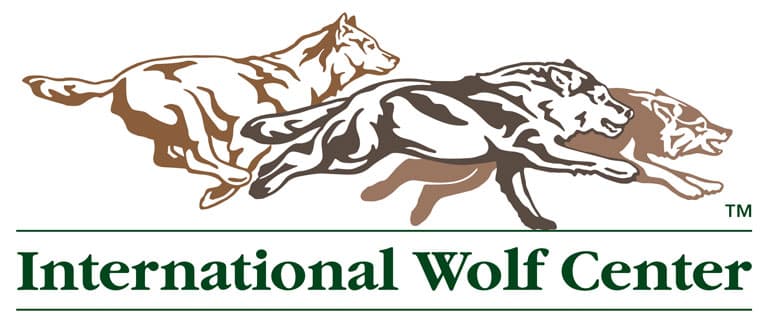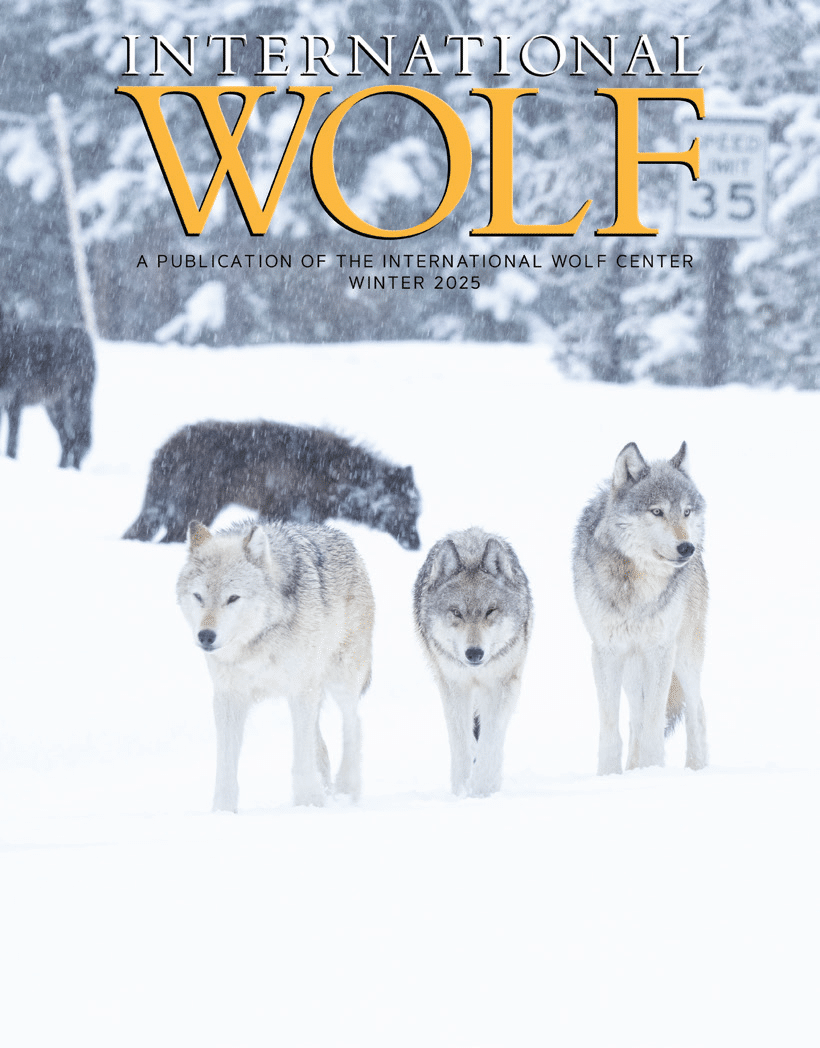International Wolf magazine is our quarterly publication highlighting all aspects of the wolf story, from ranchers’ concerns to the spiritual thrill of meeting a wolf in the wild to in-depth articles by leading wolf biologists.
Save
Our magazine archives contain a comprehensive collection of past editions of International Wolf magazine; however, issues from the last two years are only available to our members as an exclusive benefit.
Become a member of the International Wolf Center today to receive your quarterly subscription and enjoy many other benefits! Membership is the only way to receive every issue promptly upon release!
Winter 2025
Features
In Search of Wolf Scat
By Kayla Fratt
Researchers in southeast Alaska are using specially trained detection dogs to locate wolf scats containing sea otter remains, helping study the diet and genetics of the Alexander Archipelago wolf. Led by Oregon State University’s Kayla Fratt, the project combines canine scent detection with DNA analysis to reveal how these coastal wolves survive on diverse marine prey.
Wolves from the Indian Grasslands
By Víctor Sazatornil, José Vicente López – Baoand Mihir Godbole
Rapid urbanization and agricultural change in India’s Pune District are threatening the survival of the Indian wolf, an ancient subspecies adapted to monsoon climates. Researchers and The Grasslands Trust are documenting habitat loss, disease, and competition from free-ranging dogs. Despite coexistence with people for centuries, shrinking grasslands now endanger the wolves’ fragile future.
What to do with a Big Bold Wolf?
By Tracy O’Connell
As wolves recolonize populated parts of Europe, researchers are studying “bold” behavior — when wolves repeatedly approach within 30 meters of people. Most cases involve young or food-conditioned wolves, often near recolonized areas. Experts recommend prevention, documenting incidents, and removing attractants, emphasizing that boldness rarely signals aggression and should be assessed case by case.
Departments
From the Executive Director
Corndogs and coexistence
by Grant Spickelmier
Each summer, I anticipate one International Wolf Center event as much as any other program – our outreach booth at the Minnesota State Fair. There are many reasons why our involvement in the fair is important: we engage with over 23,000 people, it creates volunteer opportunities, and it allows us to meet people who might never come to the Center in Ely. I look forward to the fair especially because it allows me to get out from behind my computer and spend concentrated time talking and listening to people about wolves.
Tracking the Pack
A Pack Of Six Wolves
By Giselle M . Narváez Rivera
After a long summer of being socialized, our pups, Cedar and Rowan, are finally in the main habitat with the Exhibit Pack. The final stage of our introduction process, in which the new ambassadors meet the rest of the pack without any fencing in between, took place at the end of July. To facilitate a smooth introduction, the wolf care team brought the adult wolves into the pack holding area, an adjacent enclosure to the main exhibit, to meet the pups. The pups had been using this space for weeks and were more likely to feel comfortable and calm meeting the adults there. Using this smaller outdoor space also allowed us to monitor those initial interactions closely.
Wolves of the World
By Giselle Narvaez Rivera and Denise Hughett
ALASKA
Science has discovered recently that several wolves have elevated levels of mercury. This is occurring due to a population of wolves making the switch from terrestrial prey animals to sea otters. Sea otters have become more numerous due to their conservation and protection under the Marine Mammal Protection Act. Sea otters can be easier to prey upon than larger hoofed animals (ungulates) such as moose or deer.
MEXICO
Conservation of the Mexican wolf (Canis lupus baileyi) continues to be a topic of conversation for both the United States and for Mexico. The Mexican wolf was reintroduced in Mexico starting in 2011, which was long after the U.S. reintroduced it in 1998. The most recent (late 2024) population estimate by the U.S. Fish and Wildlife Service indicates there may be at least 286 Mexican wolves in New Mexico and Arizona. In Mexico, the most recent estimate is only 30-35 wild wolves there.
SWITZERLAND
The use of guard animals such as dogs, equids (horses) and camelids (llamas and alpacas) to protect livestock is an ancient practice and can be found in varying forms throughout the world. Donkeys, domesticated from wild African asses (Equus africanus) more than 7,000 years ago, are vigilant animals that tend to confront threats by standing their ground, baring their teeth, lunging and vocalizing loudly. This defensive nature persists when donkeys are kept with and bonded to other livestock, such as sheep, and can help provide some protection from predators.
GREECE
A recently published study estimated that wolf populations across Europe have increased by almost 60% over the past decade. Their recovery is remarkable, and they continue to recolonize many areas they once roamed. For example, after almost a century, wolves have returned to Mount Taygetus in the Peloponnese Peninsula. This mountain range in southern Greece is located near ancient Sparta and is characterized by its rich biodiversity and its various archaeological sites.
NETHERLANDS
On July 30, 2025, a mother went for a walk with her two young children in the Den Treek Nature Reserve of the Utrecht province. The mother reported that a wolf appeared and attacked her six-year-old son from behind while he was playing near the woods and then dragged him into the woods. Luckily, two people that were nearby helped the boy by “beating the animal with sticks.” Thankfully, the boy survived but reportedly suffered wounds and abrasions to his back.
Personal Encounter
Wolves and Grizzlies: My First Wolf Tracking Flight in Yellowstone
By Jeremy SunderRaj
It was my first wolf tracking flight in Yellowstone National Park, and I was excited. I had dreamed about this moment since I was a little kid. I had been on flights like this before while working for the state of Montana, but wolves were often hard to see. Usually, you don’t have the chance to observe much behavior. Yellowstone’s wolves, however, are known for their visibility. Visions of wolves chasing bison and playing with pups filled my head. I woke up before my alarm rang, sped to the airport, and hopped into the yellow Piper Super Cub, ready for takeoff.
A Look Beyond
Recovery Rebound – Renewed Hope for the World’s Rarest Wolf
By Neil Hutt and Kim Wheeler
In the spring of 2025, 16 red wolf pups in four litters were born in northeastern North Carolina where the only wild population of red wolves lives. The arrival of these pups is reason for celebration combined with cautious optimism for a critically endangered predator whose numbers five years ago had dropped to a perilously low seven known red wolves roaming free on the Albemarle Peninsula’s 1.7 million acres of wetlands, woods and farmlands. The pups, along with the formation of new breeding pairs, are tangible evidence that an imperiled species can rebound if proven science-based management practices are combined with public investment in both red wolf recovery and habitat conservation.
International Wolf Magazine Archives
Our International Wolf magazine archives contain a comprehensive collection of past editions of International Wolf magazine; however, issues from the last two years are only available to our members as an exclusive benefit.

The International Wolf Center uses science-based education to teach and inspire the world about wolves, their ecology, and the wolf-human relationship.


